Burgers are one of the things we order the most when dining out of the house: from fast food, to fast casual and gastropubs, a good or cheap (or hopefully good and cheap) burger hits the spot on so many occasions. What’s interesting when you think about it, is that burgers are also one of the easiest things to make inside the house.
With minimal ingredients and equipment and about 10 minutes, you can sizzle up one of your own with stuff you may already have on hand. If your cheese drawer and refrigerator door shelves look anything like mine, you probably even have a few creative ways to garnish a burger.
Maybe it’s the tendency to overcook a burger, or the tendency to smoke up our kitchens in the process that stops us. What if there was a way to account for both of those things? You don’t have to wait for grill season to home-cook a burger without setting off the smoke alarm, and you can take a little guesswork out of whether that burger will actually come out perfectly medium rare.
Enter, your air fryer.
I’ve been an air fryer acolyte since the moment one came into my life, but its primary employment has always been toward the perfection of frozen, fried items or the occasional piece of salmon. Why I’ve never thought to throw a burger patty in there before now is beyond me, especially when the outcome was so favorable. Here’s all you need to know about cooking a burger in the air fryer for optimal results.
The method
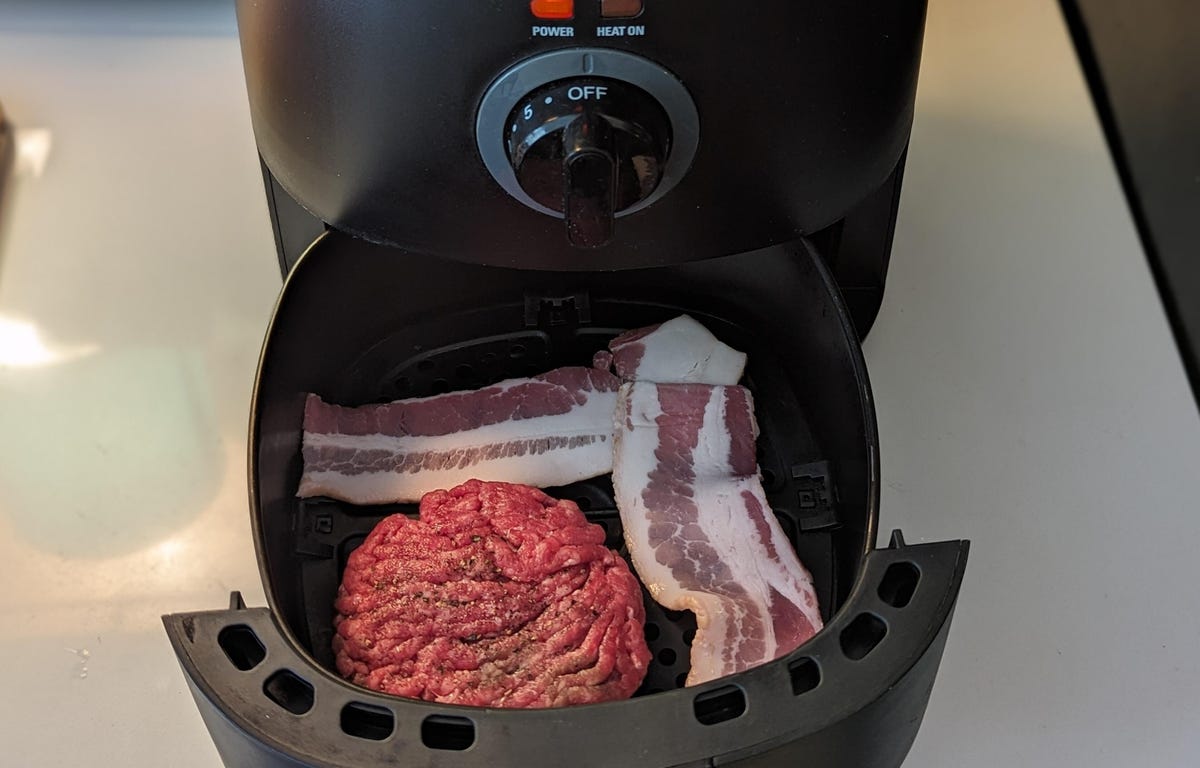
Even a small air fryer can handle a full-sized burger patty and a few slices of bacon at once.
I consulted a variety of different sources for timings and temperatures, but the process is about what you’d expect and similar to that which you’d experience cooking a burger in any manner: flipping the patty about halfway through for even results, with different timings depending on the size of your desired doneness.
Read more: Air Fryers Give Off Less Heat and Use Less Energy Than an Oven. Here’s How Much
The air fryer works by circulating hot air in its contained chamber, so as a matter of interest, your air fryer burger will cook opposite to what you’d see on a sauté pan, with the exposed side of the burger cooking more quickly and becoming browner than the underside of the patty.
I tried two different approaches, both with a quarter pound of lean ground beef, seasoned simply with salt and pepper. First, I shaped a single patty about three-quarters of an inch in thickness, and cooked it at 370 degrees F. for ten minutes, flipping at the halfway mark. Then I tried the same amount of meat shaped into two, thin, smash-style patties for a total cooking time of about six minutes. (Double your cheeseburger, double your fun.)
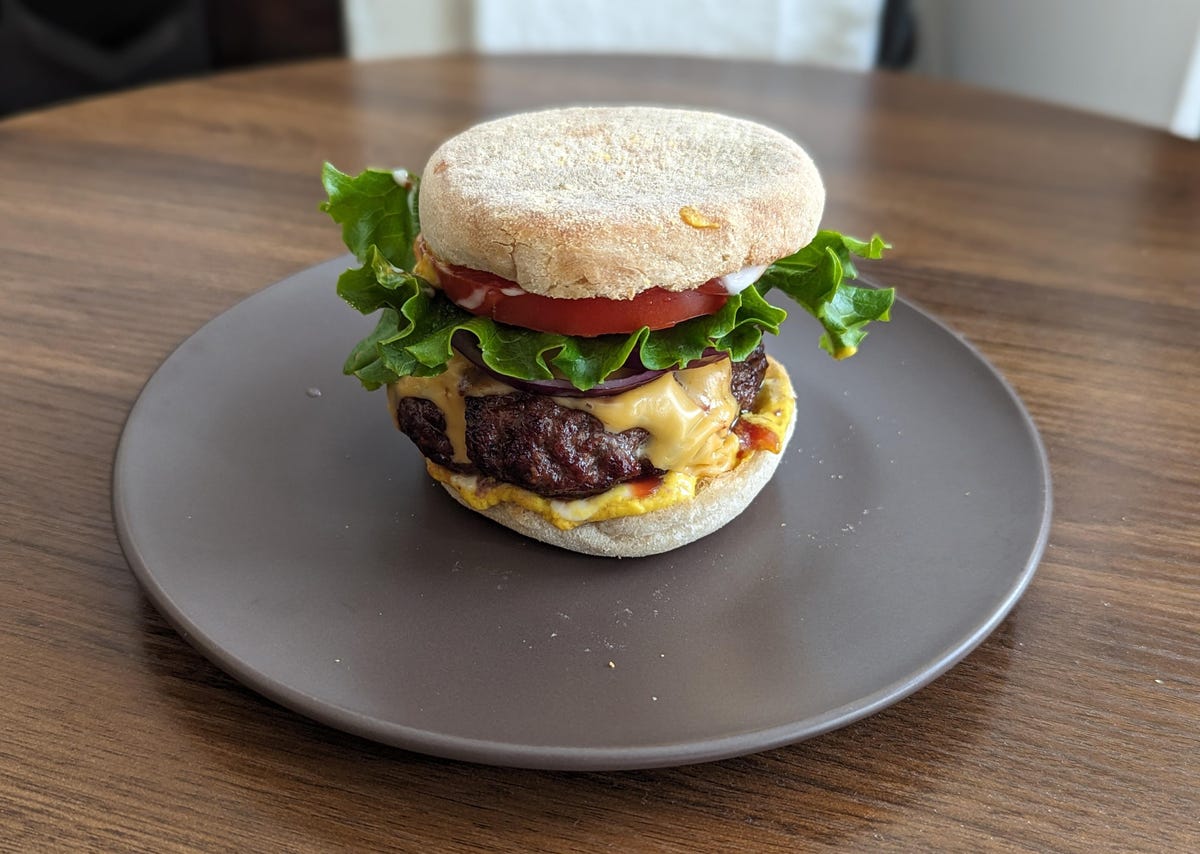
Making a great burger in an air fryer takes almost no skill and requires very little cleanup afterward.
Air fryer burger: consistent results with easy cleanup
Well, that was easy. In both cases the patties cooked evenly, with an outcome that was medium in doneness. (You can easily experiment with your model and ideal burger patty size to find the precise timings for your preferred degree of doneness.) The hot air circulation even managed to produce a bit of caramelized crust on one side. Because I could, even with a small, single-household air fryer, I put in a couple of strips of bacon with the single burger patty, since crispy, spatter-free bacon is another excellent use for an air fryer — not to mention an exceptional burger topping.
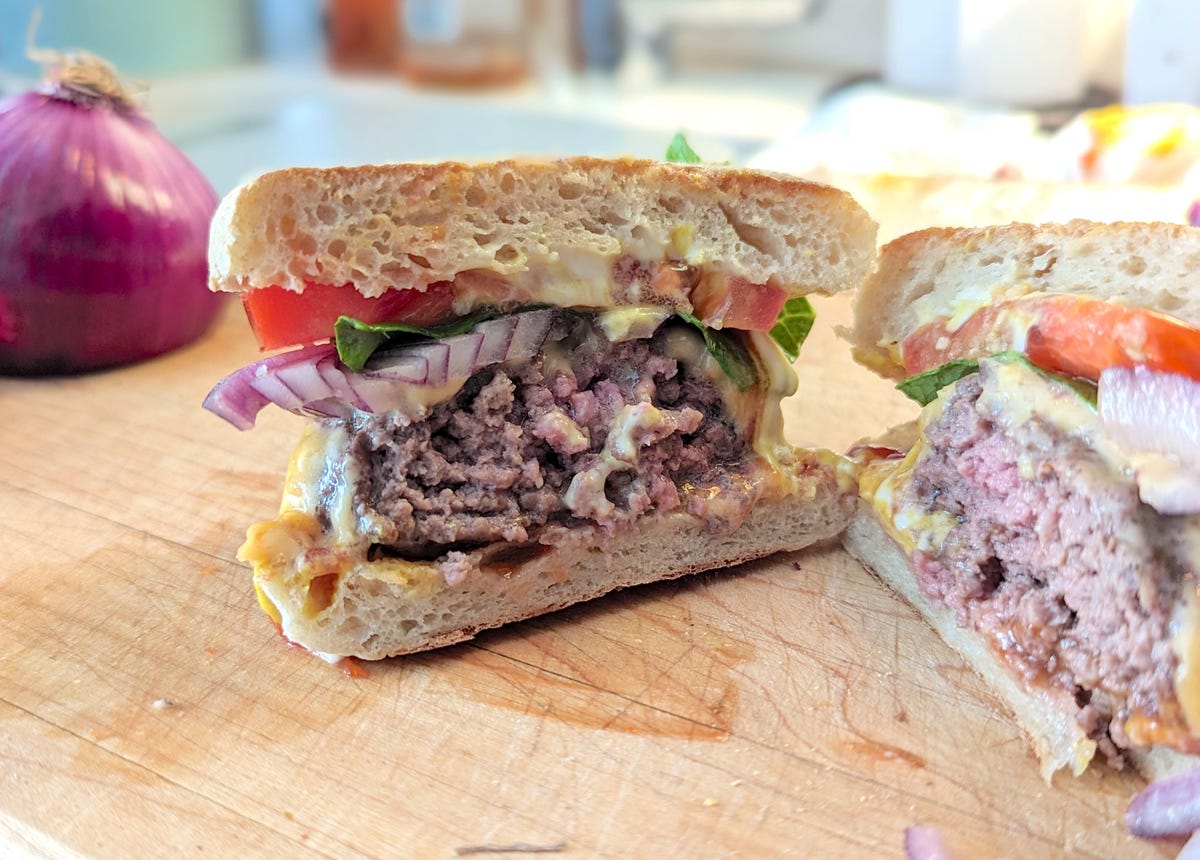
You can cook a burger to that perfect medium or medium rare with an air fryer.
Read more: I’ve Been Making Bacon Wrong. Here’s the Best (and Cleanest) Way to Cook it
Speaking of spatter-free, this is the single most compelling reason to employ the air fryer for burger prep. Safely contained within the air fryer drawer, your clothing, skin and stovetop all avoid the sizzling oil droplets that like to escape the pan during regular skillet cooking. The smoky, greasy, meaty aroma which is otherwise appealing at a burger dive, but not so much in a studio apartment, is also minimized. Cleanup was limited only to the non-stick, air fryer drawer.
Any drawbacks to making air fryer burgers?
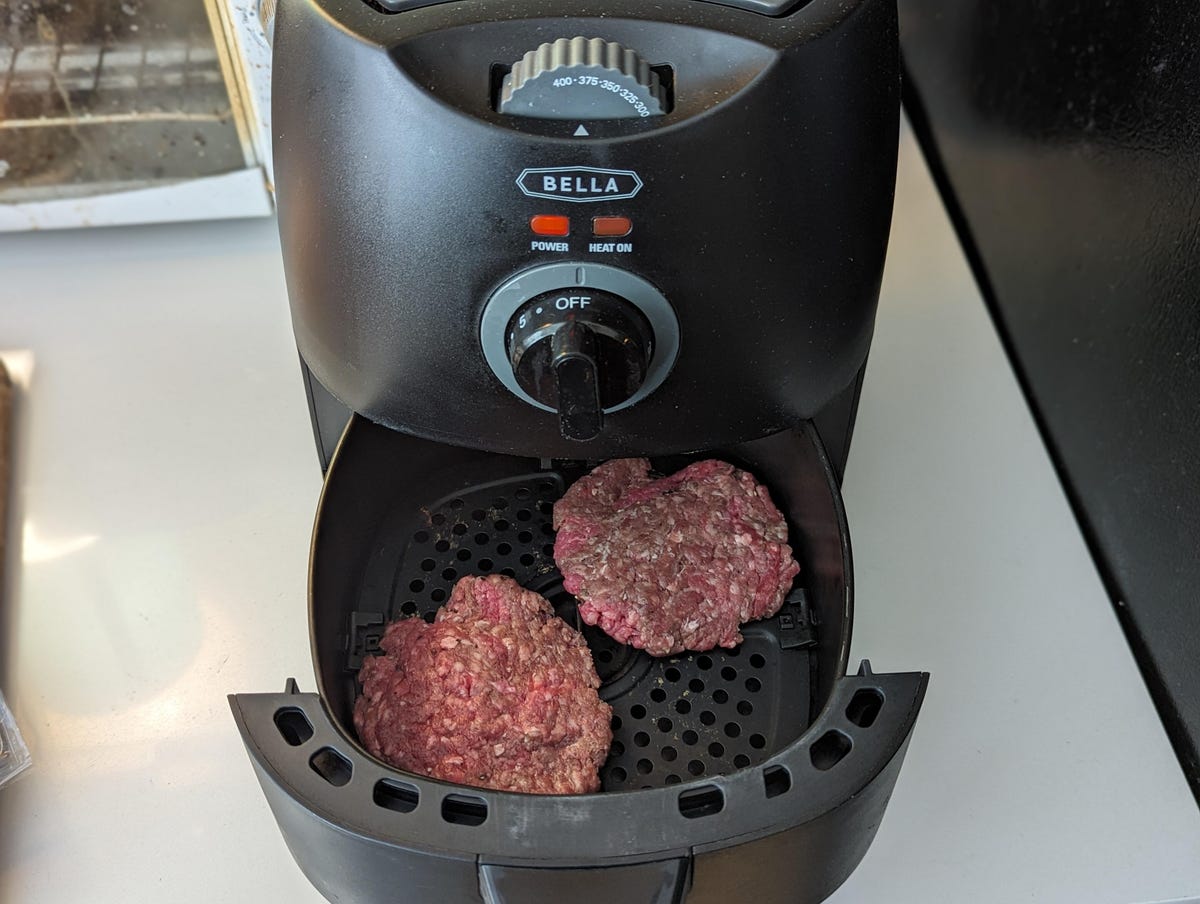
With an air fryer, you can’t smash the patties down as easily as you can on a grill or griddle.
The air fryer isn’t perfect when it comes to burgers, and the drawbacks as I experienced are twofold. First, since you can’t really access the patty while it cooks, you’re unable to smash it down in such a way that it doesn’t shrink up significantly while cooking. Since an English muffin is the best burger containment method — I will not be considering opposing viewpoints at this time — this didn’t bother me so much, since the resulting patty fits the intended vessel perfectly. Expect shrinkage when considering the size of your patty before cooking.
Second, if you’re like me and believe that a burger without cheese isn’t worth eating, things get a little more complicated. Because of the air circulation action of the air fryer, it’s hard to anchor cheese on top for a quick melt at the end of the process. My first attempt with a sliced single, an ideal burger cheese — and I am a cheese pro, so don’t come at me — flew off and unhelpfully adhered to the surface of the air fryer drawer.
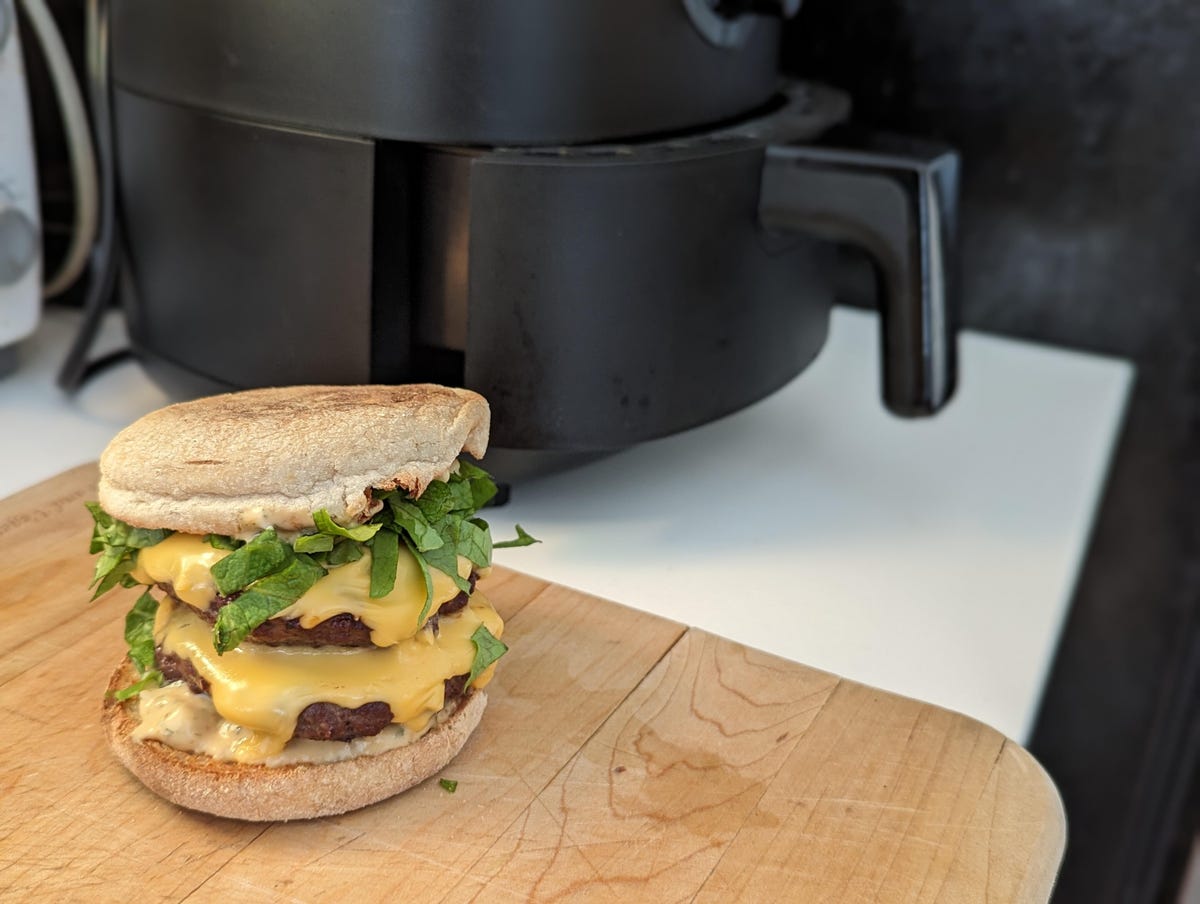
Am I seeing double?
My second attempt where a slice was halved and layered for extra heft was more successful, even more so when I moved the patties to the back edge of the fryer basket which gets less aggressive air circulation. This may just be a quirk of my model, but I’d be prepared to experiment. I wouldn’t even consider shredded cheese on top of a patty, but I absolutely would consider a cheese-stuffed burger, which should work nicely.
An alternative approach
While I didn’t attempt this personally, the internet would have you believe that all things air-fryer-burger are possible, even beginning with a frozen patty. As my household of one isn’t typically able to get through a pound of beef in one sitting, I like this option for the pre-portioned, pre-smashed patties I keep in the freezer for future burger cravings.

